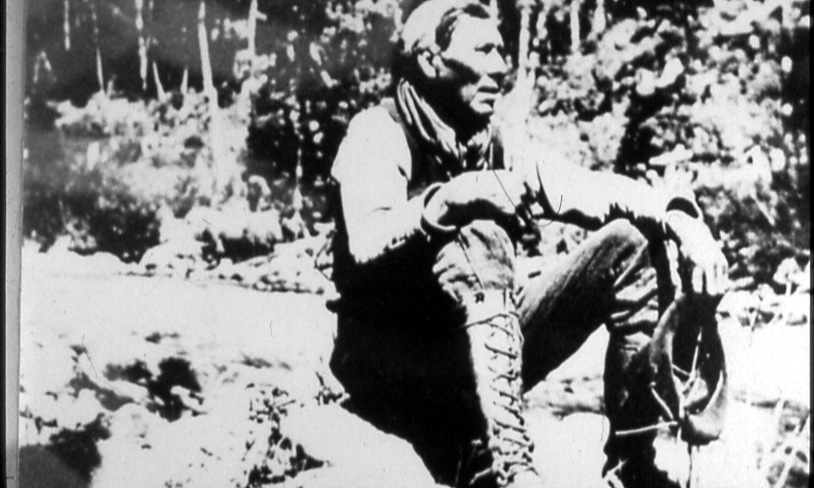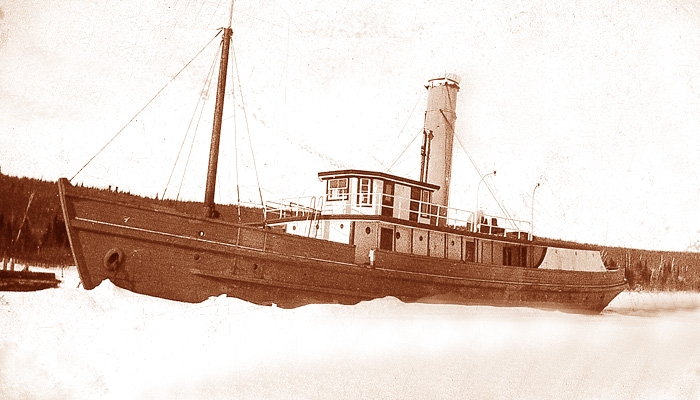When the Anglo-Newfoundland Development Company was formed in 1905 they not only acquired timber rights, they also acquired hundreds of square miles of mineral rights on the same lands. So naturally they wanted to find out if there was anything of any value lying beneath the surface.
One type of deposit the AND Co was looking for was Sulfur. Sulfur was needed in chemical pulp production and most of it as it was would have to be imported or bought from other sources. Finding a sulfur deposit was not far-fetched in Newfoundland. Many of the copper deposits in Notre Dame Bay contain a very large amount of Sulfur. Pilley’s Island was the most successful example with its copper pyrite mine being exploited chiefly for its sulfur content.[i]

So the legend says that in the summer of 1905 they sent out a prospecting party that included a Mr. William Canning and legendary Micmac woodsman Matty Mitchell. The story goes that one day they were camped near the Sandy (Now Buchan’s) River on the western shore of Red Indian Lake. Naturally they had a camp fire to boil the kettle and have a mug up. Nothing extraordinary. But what was extraordinary was the fact that the men noticed that some of the rock around the fire had melted.[ii] A less glamourous story was that Canning was a qualified prospector or Geologist and had noticed the outcrops. I am more inclined to believe that Mitchell had camped in the area before and had noticed the melted rock and took Canning back to the area.
On further examination the ore found on the Buchans River was found to be a complex base metal containing mainly zinc and lead with some copper and smaller amounts of silver and gold. So soon enough, at the same time Grand Falls was being built the AND Co got into the mining business. The mineral side of the AND Co operations was carried out through a company called Terra Nova Properties after 1907.

So at the same time construction was in full swing at Grand Falls employees of the Anglo-Newfoundland Development Company started mining on Buchans River. The original Buchans River mine site was not an easy place to get into, especially in those days. Men and supplies would have to travel to Millertown by train, then across Red Indian Lake by boat. Once on the other side they still had to trek over a woods trail to the mine site. The reverse was true for any ore that came out of the mine, out of the mine site by horse and cart, then across the lake by boat then by train after Millertown.
Preliminary work started at the “Old” Buchans mine in the summer of 1906 under the supervision of William Scott an engineer working for AND, who would soon rise in prominence at Grand Falls. Even then there were indications that the ore found there was of a complex nature. The Following year a crew of men was brought in including experienced Cornish and Newfoundland miners. Many of these men had come from Pilley’s Island since the mine there was being wound down at the same time.
A number of shafts were sunk and the area had all the makings of a frontier mine with a deck head hoist, steam engines, a sawmill and bunkhouses for the men. All this was present even though the mine was basically exploratory. As mentioned before, the ore was mineral rich, but it was also incredibly complex and at that point there was no way to economically smelt it. This said quite a bit of ore came out of the first Buchans Mine. 900 Tons of which made its way to Sweden. [iii]
The experiment at Buchan’s River went on until about 1911 when the mine was abandoned.

Meanwhile Grand Falls mill was completed; the Anglo-Newfoundland Development expanded sinking ever more money into Lord Nortcliffes venture on the Exploits. Even with all the expansions and investments, by the late 1920’s with obstacles being presented by shipping and the like Grand Falls was becoming unprofitable. At one point it has been said that they were faced with the possibility of closing up shop in Grand Falls. Around this same time the mysteries of a vast stockpile of base metal deep in the interior would be unlocked.

The American Smelting and Refining Company (ASARCO) had acquired samples of Buchan’s ore as far back as 1916. The ore was rich enough and the deposit big enough to have warranted quite a bit of research into smelting and refining methods. It took none years for a satisfactory method extracting, separating and concentrating the Buchan’s ore. The process known as froth floatation was perfected in 1925. In October of the same year mining engineers from ASARCO visited Buchans.[iv]
It was soon found that there was even more ore than previously thought. An agreement was forged between ASARCO and ANDCO/Terra Nova Properties forming the Buchans Mining Company.
Before the rich deposits could be exploited a lot of work had to be done. The prospective mine site was located a fair distance from the railway. The first winter supplies were brought in by Holt tractor over a rough portage road around the lake. Enough was brought over this way to get a start on the site and to built a landing site on the western side of Red Indian Lake. In the summer supplies and machinery were bought as far as Millertown by train. Then they were loaded on to a scow and towed across the lake by the Fleetway or one of the other logging tugs at Millertown. The scow was landed at a place called Buchans landing. From Buchans landing supplies were hauled by a Linn tractor to the new mine/town site.

In 1927-28 Goodyear and Son’s Construction of Grand Falls were contracted to build a rail line from Buchan’s to the Millertown Railway. When this was completed the site was more easily accessible. For many years this railway would be the only way in and out of Buchans. Because of this Buchans was an island in the middle of the wilderness and the only way in and out was on the “company” Railway. This gave the Buchans Mining Company unrivaled control on who could come into the company town. For many years you needed permission to get on the train to go to Buchan’s and if you had a valid reason you never got in.
In this wilderness an extensive mine completed with processing mill and other assorted buildings. To house the workers there were bunkhouses and company houses.
The mine at Buchan’s also necessitated the expansion of the port of Botwood where an ore shed and shipping facilities were built. A lion’s share of the shipping was handled by the AND Co. The First load of concentrates was shipped out of Botwood in September of 1928. The ore was loaded on the S.S Kiruna.The first shipment was not without incident since the load shifted on board and the Kiruna had to return to port.

On the eve of the Great Depression the mine at Buchans and the mill at Grand Falls had turned Central Newfoundland into the economic power house of the Island, exports of mineral and forest products dwarfed those of the fishery.Because of the 50-50 arrangement the AND Co had with ASARCO, the A.N.D Co was entitled to 50% of all of the profits from the Buchans mine. They say that Buchan’s was so profitable in its heyday that any profits made by the Grand Falls mill just gravy. To further elaborate on this there are legends and tales about the gold and silver that came out of Buchan’s. I have heard that once a year there was a special train that came out of Buchans that carried all of the gold that had been extracted over the past year and that the gold and silver that came out amounted to enough to cover the payroll of not only the Buchans Mine but the Grand Falls mill as well.

Over 55 years some 17.5 million tons of ore were mined and processed at Buchans.[v] The profit sharing arrangement with Anglo-Newfoundland (After 1965 Price) cushioned the Grand Falls mill against uncertainties in the pulp and paper industry. But all good things must come to an end, during the 1970’s arrangements were made that loosened Price’s hold on mineral rights and at the same time the Buchans mine was becoming exhausted. In 1984 the Buchans mine closed.
[i] Pilley’s Island mine closed in 1908. Around this time it was discovered that sulfur could more cheaply be extracted as a byproduct of oil refining than from mining. The AND Company was also particularly interested in finding coal deposits and carried out extensive explorations of coal deposits on the west coast.
[ii] https://journals.lib.unb.ca/index.php/GC/article/view/18540/20101
[iii] Ibid
[iv] Ibid
just wondering if any of the First Nations got anything out of their land ..
LikeLike
Doubt it. The Beothuck were the native first nations of the area and they were long gone. The Mic Mac hunted and trapped in the area but there is no proof they were in Newfoundland prior to European settlement.
LikeLike